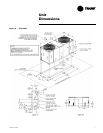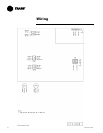
PKG-SVX17A-EN 11
Note: Insulate all refrigerant piping
and connections.
Refrigerant Piping Procedures
(Outdoor Units)
Each CTA unit ships with a holding
charge of dry nitrogen. The nitrogen
should be removed and the entire sys
-
tem evacuated (at the proper time) to
avoid possible contamination.
1. Remove the service access panel.
2. Locate the liquid and discharge
lines. Check that the piping connec-
tion stubs on the valves (Figure 6)
line up properly with the holes in
the unit cabinet.
Figure 6
3. Locate the gauge ports on the dis-
charge and liquid lines. Depress the
valve core to release the nitrogen
from the unit.
Note: If nitrogen is not released from
the unit, there is a leak in the system.
Locate the leak and repair before pro
-
ceeding with the installation.
4. Unbraze the tube seal caps to reveal
the line braze connections.
WARNING:
Hazardous Pressures!
Coil has a nitrogen holding
charge. Do not remove seal caps
by heating the caps while coil is
under pressure. Depress the
gauge port valve cores to gradu
-
ally relieve nitrogen holding
charge. Remove valve cores
before removing the tubing seal
caps. Failure to properly relieve
pressure could result in death or
serious injury.
CAUTION:
Equipment Damage!
Do not remove the seal caps from
refrigerant connections until pre
-
pared to braze refrigerant lines to
the connections. Excessive expo-
sure to atmosphere may allow
moisture or dirt to contaminate
the system, damaging valve seals
and causing ice formation in sys
-
tem components.
5. Cut, fit and braze tubing, starting at
the outdoor unit and work toward
the indoor unit.
Note: Use long radius bells for all 90
degree bends.
All brazing should be done using a 2
to 3 psig dry nitrogen purge flowing
through the pipe being brazed (Figure
6).
WARNING:
Hazardous Pressures!
When using dry nitrogen cylin-
ders for pressurizing units for
leak testing, always provide a
pressure regulator on the cylinder
to prevent excessively high unit
pressures. Never pressurize unit
above the maximum recom
-
mended unit test pressure as
specified in applicable unit litera-
ture. Failure to properly regulate
pressure could result in a violent
explosion, which could result in
death or serious injury or equip
-
ment or property-only-damage.
CAUTION:
Equipment Damage!
Wet-wrap all valves and protect
painted surfaces from excessive
heat. Heat can damage system
components and the unit finish.
6. Shut off nitrogen supply.
7. Shut off the manifold valve for the
line that is connected to the dis
-
charge line gauge port.
Figure 7
Refrigerant Piping Procedure
(Indoor Unit)
Once liquid and discharge lines are
complete to the refrigerant connec
-
tions on the indoor unit, depress the
gauge port valve cores on the suction
and discharge lines to gradually
relieve nitrogen holding charge.
Installation


















